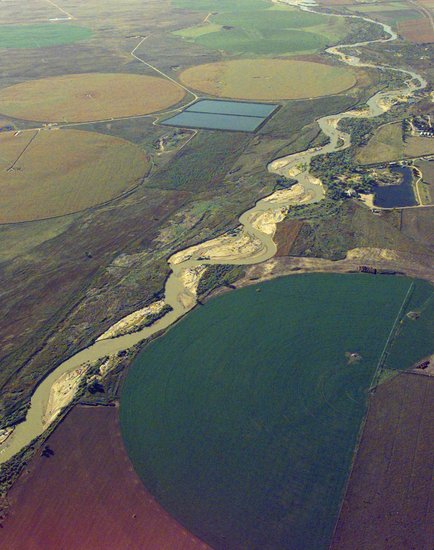A vast underground lake beneath western Kansas and parts of seven other states could be mostly depleted by 2060, turning productive farmland back to semi-arid ground, a new study says.
The life of the Ogallala Aquifer could be extended several decades, but only if water usage is reduced, a four-year study by researchers from Kansas State University found.
“There is going to be agriculture production in Kansas and corn production and cattle production really for the foreseeable future,” David Steward, lead author of the study, said in an interview last week.
But without conservation, he said, “the future is bleak.”
The aquifer yields 30 percent of the nation’s irrigated groundwater, the study said. It could last until 2110 or longer if farmers were to cut 20 percent of their usage or more beginning now. But that would reduce agriculture production to the levels of 15 or 20 years ago.
Kansas alone pumped 1.3 trillion gallons in 2011, more than enough to fill Lake Okeechobee, the huge lake in Florida.
The study was done because there are a lot of questions about “how long can we pump and how long it will take to recharge the aquifer if depleted,” Steward said.
The study determined it would “take in the neighborhood of 500 to 1,300 years to recharge the aquifer” in western Kansas, Steward said.
Water from the aquifer lies under 175,000 square miles in Kansas, Nebraska, South Dakota, Colorado, Oklahoma, Texas, Wyoming and New Mexico. The aquifer first began declining in the 1960s because of irrigation needs.
At the current rate, the aquifer will be 70 percent depleted by 2060, according to the study.
Kansas in recent years has begun trying to come up with ways to keep the lake recharging at a rate that doesn’t allow the resource to dry up.
In 2012, Gov. Sam Brownback sponsored special legislation that permits groups of farmers and producers within a groundwater management district to implement their own conservation plans.
Some farmers supported the legislation strongly because they knew that if they didn’t “they are going to lose their opportunity to irrigate totally,” said Terry Vinduska, a Marion corn farmer. “That will leave them in the desert.”
This spring a group of farmers in northwest Kansas, taking advantage of the state legislation, voluntarily agreed to reduce their water use by 20 percent over the next five years. Their area covers 99 square miles.
It was a difficult task getting all farmers who own land within that area to agree on ways to conserve, said Wayne Bossert, manager of Groundwater Management District 4 in Colby.
“It’s not perfect the way we did it,” Bossert said. “Most agreed. Not everybody was in favor. But it was a strong super-consensus that this proposal be submitted.”
So far they are the only ones to do so, but other western Kansas farmers are watching, Bossert said.
The state approved the plan, which now affects all farmers in that area, including portions of Sheridan and Thomas counties.
Drought and the planting of more cropland have increased the amount of water drawn from the aquifer, so the economic impact of water reduction is a major concern. But farmers are aware that if they use up the resource, their children and grandchildren will be hurt, said Aaron Harries with Kansas Wheat, which includes the Kansas Wheat Growers Association.
“It is a forward-thinking decision and a long-term decision where you have to think about future generations wanting to use that water,” Harries said. “But it is a difficult decision to cut back on that water, especially with summers like we had in western Kansas this year. That water can be the difference between making a crop and not making a crop.”
Nebraska already has taken action. A decade ago, the state legislature decided to conserve because 90 percent of the drinking water comes from the aquifer, said Doug Anderson, Keith County extension educator.
“Water is a touchy subject,” Anderson said. “Most of the farmers understand we can’t go back to the ’60s, ’70s and ’80s and dig a hole in the ground and pump as much as we want. Water is a big topic and is going to continue to be a big topic, especially if the world population keeps going up the way it is.”
The K-State study warned that farmers needed to act quickly to conserve water.
“Society has an opportunity now to make changes with tremendous implications for future sustainability and livability,” Steward wrote in the study. “The time to act will soon be past.”
To reach Karen Dillon, call 816-234-4430 or send email to kdillon@kcstar.com.
http://www.kansascity.com/2013/09/01/4452173/the-ogallala-aquifer-an-important.html
